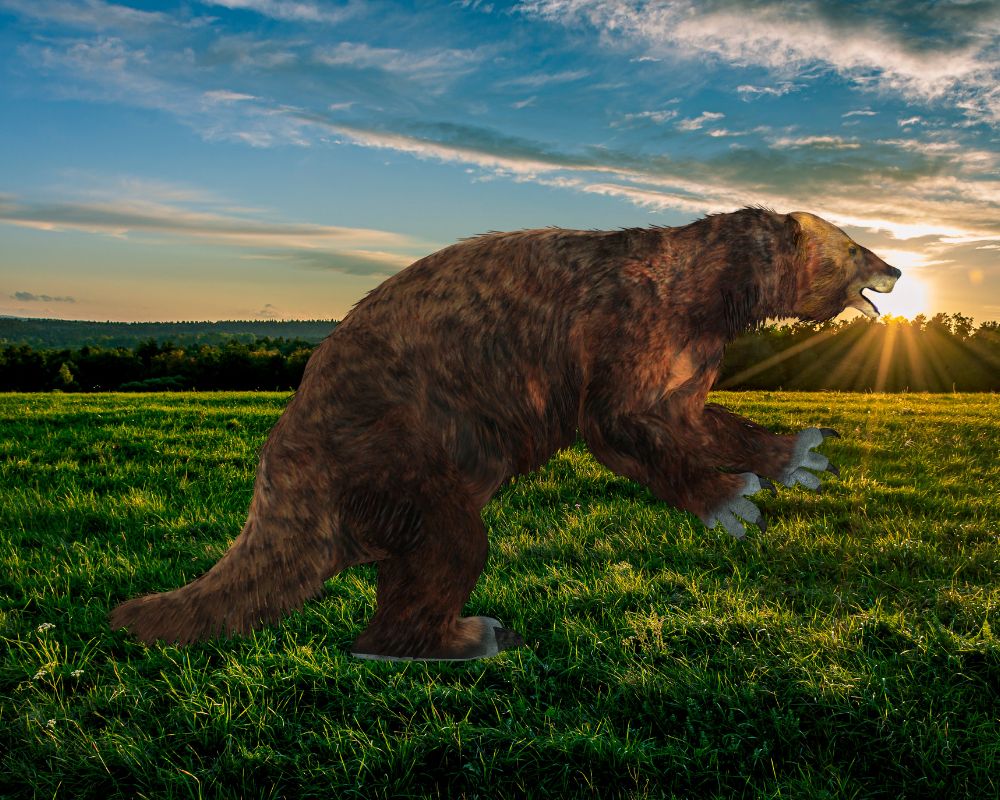The battle between the Giant Sloth and the Ceratosaurus would be a match between brute strength and speed. And unfortunately for the Giant Sloth, the speed and aggressive nature of the Ceratosaurus would land it in this dino-battle victory circle.
Table of Contents
Battle Facts about Giant Sloth vs. Ceratosaurus

| Name | Giant Sloth, (Megatherium), Giant Ground Sloth | Ceratosaurus, (Ceratosaurus nasicornis) |
| Size | 12 feet tall, 22,000 pounds | 18 feet long, 3,000 |
| Speed | very slow | 30 mph |
| Offense | Long arms with sharp claws used for stabbing | Quick speed, razor-sharp teeth |
| Defense | Massive size | Fast |
| Endurance and Behavior | Slow-moving | Hunts in packs |
The Giant Sloth and the Ceratosaurus were not neighbors. They lived on separate continents and over 100 million years apart. As one of the largest land mammals ever, the Giant Sloth was a wall of muscle with dagger-like claws used to piece opponents.
The Ceratosaurus, on the other hand, could reach speeds of up to 30 miles per hour and had a mouthful of teeth that were up to 7 inches long!
What was the Difference Between a Giant Sloth and a Ceratosaurus?

The Giant Sloth and the Ceratosaurus were two completely different animals. The Giant Sloth was a land mammal (not a dino) that lived in South America during the Pliocene age, around 5 million years ago.
The Ceratosaurus, on the other hand, was a Theropod dinosaur from North America (Utah) that lived about 150 million years ago. They were two creatures separated by approximately 145 million years.
How did they hunt?
They were also two completely different hunters. The Ceratosaurus was fast and vicious, like a smaller T-Rex or an Allosaurus.
It used its quick speed and powerful jaw to capture and kill its prey. It was also a scavenger that ate larger dinos that were already dead, like a Stegosaurus or a Giganotosaurus.
The Giant Sloth was slower, and paleontology still debates whether this giant land mammal was an herbivore or a carnivore.
How Big Was a Prehistoric Giant Sloth?
The Giant Sloth was one of the biggest land mammals ever to walk planet Earth.
Today, modern sloths are small, and the prehistoric Giant Sloth was almost ten times as big. Standing on its hind legs, it was nearly 12 feet tall and weighed 22,000 pounds. It was about as tall as two refrigerators and heavy as an African elephant!
How Big Was the Ceratosaurus?

The Ceratosaurus was about 6 feet tall and could reach 25 feet in length. It was surprisingly lightweight, given its size.
A mature Ceratosaurus weighed about 3,000 pounds. Its large frame and lighter weight made it a swift and agile hunter, which was terrible news for a Giant Sloth. Its strong back legs allowed the Ceratosaurus to reach top speeds of around 30 miles per hour.
How Strong Was the Ceratosaurus?
The Ceratosaurus was a strong, speedy theropods dino but wasn’t as strong as similar Cretaceous dinos like the Velociraptor, Baryonyx, or Spinosaurus. While it wasn’t as physically strong, its teeth struck fear in neighboring sauropods like the Iguanodon or the Diplodocus.
Compared to other theropods of the time, the teeth of the Ceratosaurus were massive. The razor-sharp teeth of the Ceratosaurus measured almost 7 inches long!
How Strong Was the Giant Sloth?
The Giant Sloth was like a giant wall of sheer muscle. It has strong, powerful legs it used to hoist 22,000 pounds of body weight! That’s like an adult African elephant standing on its back legs — so you know it had to be strong.
Its neighbors in South America knew better than to pick a fight with this strong creature. Sure, it was slow, like an Apatosaurus, Ankylosaurus, or Brachiosaurus, but it had blades for hands and massive body weight.
Who Would Win in a Giant Sloth vs. Ceratosaurus Battle?
The winner of this dino battle is a slam dunk. The Cerato would be the winner. The Giant Sloth may have been a wall of muscle and blade-like claws, but its slow sloth-like speeds were no match for the zippy Ceratosaurus.
The Ceratosaurus would use its speed and razor-sharp teeth to dig into the Giant Sloth. The Giant Sloth could land a few blows with its dagger claws, but the Ceratosaurus could easily outmaneuver the slow-moving Megatherium.
